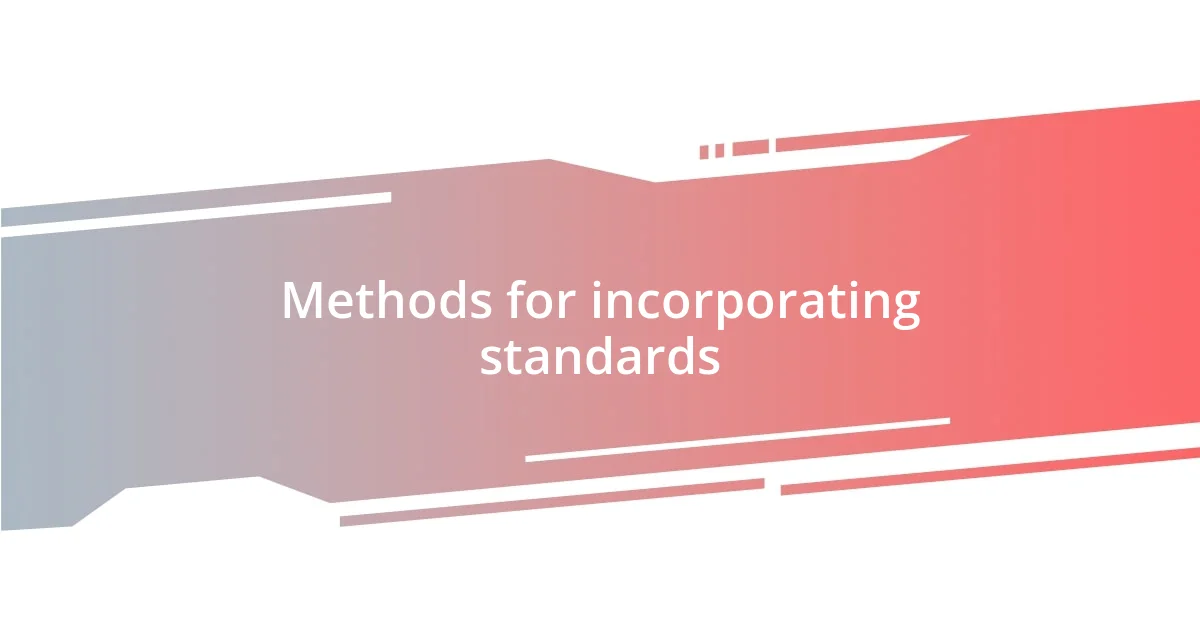Key takeaways:
- Integrating product design standards from the beginning enhances quality, ensures compliance, and fosters collaboration among teams.
- Utilizing practical methods such as checklists, iterative design cycles, and collaboration tools significantly improves the integration of standards into the design process.
- Continuous improvement through feedback loops and systematic testing not only refines designs but also cultivates a culture of innovation and accountability within teams.

Understanding product design standards
Understanding product design standards is essential for creating effective and user-friendly products. I remember my first project where I overlooked safety standards, thinking they were just formalities. The moment I received feedback highlighting compliance concerns, I felt a mix of embarrassment and urgency; it was a wake-up call that taught me the critical importance of incorporating standards from the onset.
Standards act as a common language among designers, manufacturers, and customers. They help ensure that products not only meet reliability and safety requirements but also resonate with user expectations. It’s fascinating to see how adhering to these benchmarks can elevate the user experience—consider how an intuitive interface can enhance usability, making customers feel valued and understood.
As I navigate through the product design landscape, I often ask myself: How do we balance creativity with compliance? It’s a delicate dance. Each time I incorporate standards, I find that they actually spark creativity—forcing me to think outside the box to innovate while still aligning with essential guidelines. This realization has transformed my approach; standards are not constraints but rather a foundation upon which innovative designs can flourish.

Importance of integrating standards
Integrating standards into product design is crucial because it fosters quality and consistency. I recall a time when I developed a tech gadget without thoroughly considering industry standards. The result? A product that was innovative but failed to achieve certification, which ultimately delayed its launch. This experience underscored how vital it is to embed standards in the design process from the beginning, ensuring a smoother pathway to market readiness.
When I think about the importance of standards, I often reflect on how they enhance collaboration among teams. Working with diverse experts, I’ve noticed that a clear framework provided by standards unites our efforts. It’s like having a common playbook; we can innovate faster without losing sight of what matters most—the user. This unity not only fosters a sense of shared purpose but also builds trust, which I believe is essential for any successful project.
Moreover, adhering to established standards can significantly mitigate risks associated with product failures. For instance, I once took a shortcut in a project, thinking I could bypass certain regulations to meet a tight deadline. The repercussions were severe—a recall that cost time, resources, and my reputation. Thankfully, I learned that taking the time to integrate standards isn’t just a box to tick; it’s a safeguard that protects both the consumer and the designer, ultimately enhancing the longevity of the products we create.
| Importance | Impact |
|---|---|
| Quality Assurance | Ensures reliability and durability of products. |
| Collaboration | Fosters teamwork and shared goals among designers and engineers. |
| Risk Mitigation | Reduces the likelihood of product recalls and safety concerns. |

Identifying relevant design standards
Identifying relevant design standards is the first step in ensuring that a product aligns with necessary guidelines and user needs. Early in my career, I faced a pivotal moment when I was tasked with incorporating eco-friendly materials into a project. I thought I understood the sustainability standards, but as I delved deeper, I discovered specific regulations I had overlooked. This experience taught me that thorough research and understanding are crucial in spotting the right standards before I begin designing.
Here’s a concise approach to identifying relevant design standards:
- Research Industry-Specific Standards: Explore standards relevant to your product category. Whether it’s automotive, electronics, or consumer goods, each field has its own set of guidelines.
- Consult Regulatory Bodies: Reach out to organizations or agencies that govern standards in your area. They can offer insights and resources.
- Engage with Industry Professionals: Networking with peers can help uncover insights into effective standards that others have successfully implemented. Personal stories about challenges faced can often shed light on which standards truly matter in practice.
- Stay Updated: Standards evolve, so keeping abreast of any changes ensures ongoing compliance and relevance.
Recognizing these steps can significantly shape the design journey. I vividly recall attending a workshop on user accessibility standards; it not only expanded my knowledge but also inspired me to integrate features that accommodate all users. The realization that standards are living documents, subject to change, invigorated my passion for design—reminding me that each project is an opportunity to learn and improve continuously.

Methods for incorporating standards
Integrating standards effectively into product design involves several practical methods that can streamline the process and enhance outcomes. One method I find invaluable is implementing a checklist during the design phase. I remember a project where I created a prototype without a formal checklist for safety standards. It was a stressful moment when the prototype failed a critical evaluation. By embedding a checklist in future projects, I not only reduced the hassle of revisions later on but increased my confidence that every standard had been satisfied from the get-go.
Another approach is to adopt iterative design cycles that allow for continuous feedback. I experienced this firsthand while working on a consumer electronics project. By presenting prototypes at various stages to end-users and regulatory experts, I received real-time feedback that directly influenced the product’s compliance with usability standards. This experience taught me that the iterative cycle is a robust method to weave standards into the fabric of the design process, transforming feedback into a powerful tool for improvement.
Collaboration tools can also play a significant role in integrating standards, especially when working with cross-functional teams. During an intense project, I utilized a shared digital platform to track compliance and document discussions surrounding standards. I often think about how much smoother the workflow was when everyone was on the same page. Did this tool eliminate misunderstandings? Absolutely! By using such technology, I found that not only were we meeting standards more consistently, but we were also cultivating an environment of transparency and collective ownership in our design solutions.

Tools for standard compliance
In my experience, a variety of tools can significantly enhance standard compliance in product design. For instance, I’ve found that specialized software, like compliance management systems, streamlines the process of tracking standards. Once, while developing a new product line, I implemented such a tool that allowed us not only to catalog different regulations but also to update them in real time. The relief I felt knowing that our team was always on the same page regarding compliance was priceless.
Another set of tools that deserves mention are template libraries for documentation. These templates can be a lifesaver, especially when you are dealing with multiple standards across various projects. I remember a hectic week where I needed to produce documentation for multiple designs. Utilizing pre-formatted templates helped me save a ton of time and ensured that all necessary compliance information was included. Have you ever rushed to meet a deadline and wished you had a more organized approach? Well, I have, and that experience taught me the value of having comprehensive template libraries at my disposal.
Lastly, I can’t emphasize enough the importance of training and educational resources. Investing time in workshops or online courses about regulatory standards can make a substantial difference. I discovered this during a particularly challenging project when I attended a comprehensive training session on new environmental regulations. The clarity I gained empowered me to redesign certain aspects that had initially seemed compliant but actually weren’t. Feeling equipped with knowledge not only boosted my confidence but also enhanced my design outcomes.

Testing and validating designs
When it comes to testing and validating designs, I often lean on user testing as a pivotal part of my process. One time, I orchestrated a series of usability tests for a product aimed at seniors, and the results were eye-opening. I remember watching users struggle with an interface feature I thought was intuitive. Their honest feedback drove me to rethink that element entirely, ultimately leading to a much more user-friendly design. Have you ever had your assumptions challenged in a way that completely reshaped your project? It’s moments like these that reinforce the importance of real-world testing.
Additionally, I’ve learned the significance of compliance testing in my projects. There was a time when I neglected to conduct thorough regulatory checks until late in the design phase, which led to a series of frustrating revisions. Since then, I prioritize early compliance assessments to catch potential pitfalls before they escalate. This proactive approach has saved me time and headaches, allowing my team to focus on innovation rather than scrambling to fix compliance issues at the last minute. Don’t you think getting ahead of possible setbacks can create a much smoother workflow?
Lastly, I find that having a validation protocol in place not only enhances product reliability but also boosts my team’s morale. Early on, I started documenting every iteration and the corresponding test results, which gave everyone a clear view of our progress and setbacks. I vividly remember a project where celebrating small victories from our testing results kept the team motivated during long hours. Isn’t it comforting to know that each evaluation paves the way for greater success? My experience has shown that a solid validation process fosters a culture of continuous improvement and accountability within the team.

Continuous improvement and feedback loops
Continuous improvement hinges on the valuable insights we gain from feedback loops. I can’t tell you how many times a simple post-project review has illuminated aspects I hadn’t considered. There was a product launch where immediate feedback revealed a design flaw I’d overlooked. It felt disheartening at first, but that moment crystallized for me the power of constructive criticism. Engaging with teams for their perspectives not only fosters a culture of openness but also inspires ongoing development.
Incorporating feedback doesn’t stop after the first iteration; it’s about creating a rhythm of learning and adapting. I recall a time when our team implemented a monthly check-in to discuss design progress and hurdles. These discussions frequently led to adjustments that fine-tuned our outputs beyond what I initially envisioned. Have you found a method of collecting feedback that truly supports your design goals? For me, having a systematic approach to gather insights ensures that we stay aligned and keep improving.
I’ve also discovered that celebrating the changes driven by feedback amplifies motivation. After implementing a suggestion from a team member that radically improved user interaction, I organized a small team gathering to acknowledge that leap forward. The joy in their eyes reminded me of why I love this work—every bit of feedback can lead to a breakthrough. Don’t you agree that recognizing contributions, big and small, reinforces our commitment to continuous improvement? The journey truly becomes richer when we collectively strive for betterment.















